🪱 Root Knot Nematodes
Species, Biology, Symptoms, Integrated Management
Which of the following is correct regarding Meloidogyne?

Figure 1: Meloidogyne sp. A. Female, B. Female Anterior Region, C. Male, D. Male Tail, E. Second Stage Juvenile
- Meloidogyne spp.
- The generic name Meloidogyne is derived from Greek words:
- melon: apple or gourd
- oides, oid: resembling
- gyne: female
- Meaning apple or gourd (melon) like or shaped females, the shape which they acquire upon maturity.
- Barkley in 1855 first reported the occurrence of root gall on glass-house grown cucumber in England.
- In India, it was first reported by Barber in 1901 on tea (Kerala). It was also the first ever reported plant parasitic nematode in India.
Species
- M. incognita: Present throughout India on vegetables like tomato, potato, brinjal, chilli, okra, cucurbits etc.
- M. exigua: Found on coffee in Karnataka.
- M. hapla: Restricted to temperate parts (on cool hilly area).
- M. arenaria: It is a serious pest of groundnut in Gujarat.
- M. brevicauda: Found on tea in Assam.
- M. graminicola: Found on rice in eastern part of country.
- In Meloidogyne the Perineal pattern present on vulva-anus area which is helpful in species identification.
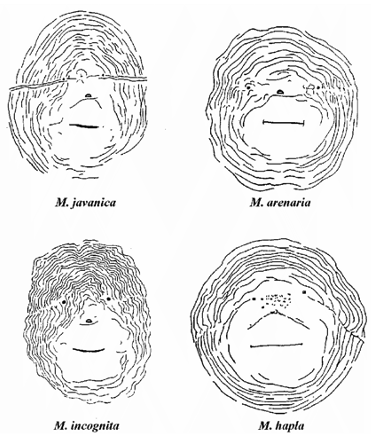
Biology
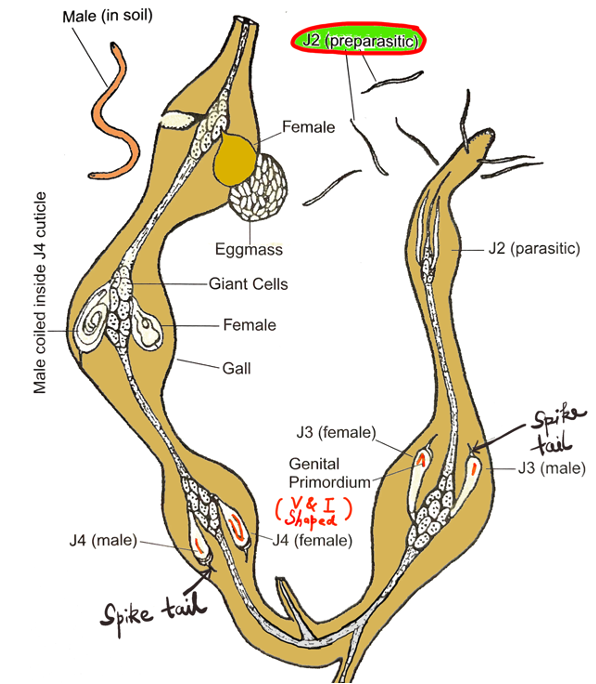
- The root – knot nematodes are sedentary endoparasites of underground plant parts.
- The eggs are retained in a gelatinous matrix, which normally protrudes out of the host tissues. About 200 to 400 oval eggs are found in a single egg mass which makes its size larger than the female body.
- The life cycle starts from the egg usually in the one-celled stage deposited by the female.
- Development of the embryo starts within hour of deposition, resulting in two, four, eight cells, etc.,
- The embryo and the first stage larva move within the egg but not very active.
- After the first moult, the second stage infective juvenile is formed within the egg. Larval hatch occurs under suitable physical condition but not depending on host root exudates or hatching factor. The emerging second stage larvae (J2) are found free in the soil. It is the only infective stage. They attack new host root tissue in the region behind the root tip (meristematic zone).
- The larvae which develop into females establishes feeding site in the pericycle region and become sedentary. Subsequently three moults occur and the larvae develop into females with spherical body embedded in the host tissue. The neck region is unaltered.
- During feeding the larvae pierce the cell wall with secretions cause enlargement of cells in the vascular cylinder and increased cell division in the pericycle. The nematode feeding stimulates the development of a typical nurse cell system called ‘Syncytium’ or ‘Giant cell’.
- These cells are multinucleate (karyokinesis is not followed by cytokinesis) which contain dense cytoplasm and enlarged nuclei with several mitochondrial and golgi bodies and are metabolically active.
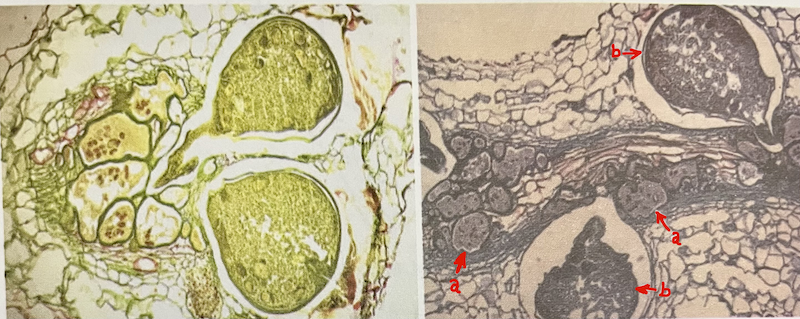
a. Giant cells, b. Nematode Meloidogyne spp.
- The J3 and J4 retain old cuticles, the pointed tail of J2 still visible and hence are called as spike-tailed stages. Sex differentiates occurs in late second juvenile stage (J2) where the genital primordial is become ‘V’ shaped in female and ‘I’ shaped in male.
- Sexual reversal: In Meloidogyne some time under adverse conditions male changed into female.
- The larval which develop into adult males are initially parasitic. After moulting three times they leave the host as a worm like from and come closer to the females for copulation.
- Reproduction is generally parthenogenetic.
- For development of a mature female it takes around 30 days which may vary depending upon the species of the host and parasite and environmental factors like temperature and soil type.
- The whole lifecycle is completed in about 25 days at 25 to 30 °C, which is optimum for most species. During winter season under North Indian conditions, the life cycle duration may be prolonged to 60-80 days depending upon prevailing temperature. Thus 7-8 overlapping generations are completed in a year.
Symptoms
Above Ground
- The above ground symptoms are not diagnostic.
- Some common symptoms are Stunted growth, yellowing of foliage, wilting during hot dry periods particularly in broad leaf crops, undersized fruits and reduced yields.
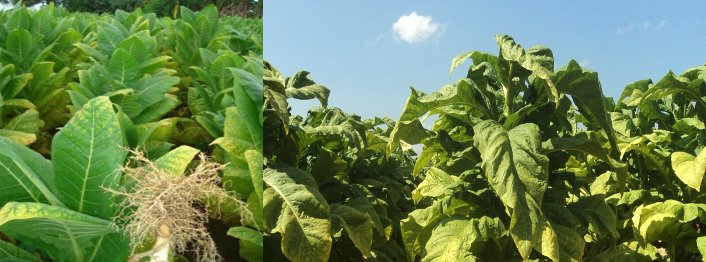
Below Ground
- The reaction to the entrance of the larvae is the development of hypertrophy (enlargement of cell size due to nucleus division i.e., karyokinesis) of cortical cells and formed 6-10 Giant cells from which it derives food.
- Nematodes secrete protease enzyme results break down protein into amino acid (tryptophan) which is a precursor of IAA is important and responsible for creating hormonal imbalance at site of reaction. Due to excess IAA formation at feeding site cause gall or knots on roots.
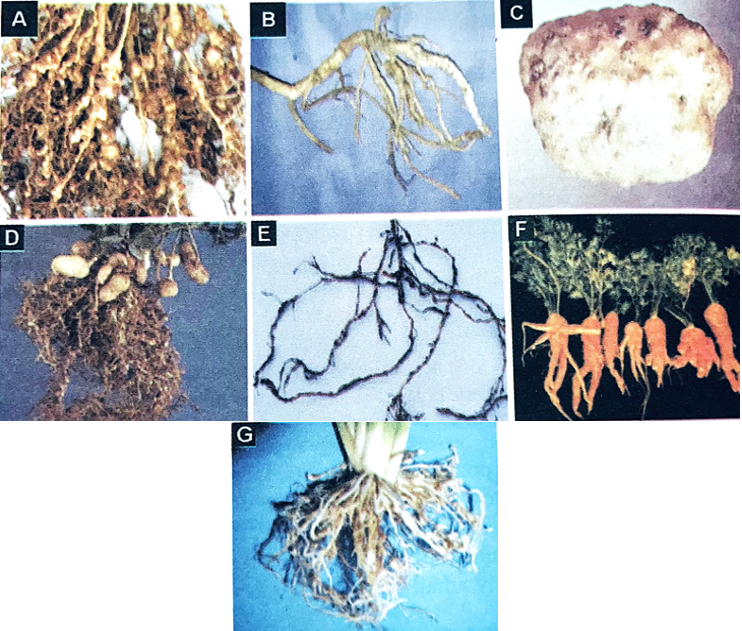
Root galling due to Meloidogyne sp: A. Tomato, B. Bottle Gourd, C. Potato Tuber, D. Peanut, E. Grapevine, F. Carrot, G. Rice (Source: Sasser, 1971)
👉🏻 Difference between root knot and rhizobium nodules:

Integrated Management
- 2-3 Deep summer ploughing in May/June is very effective to kill quiescent J2 stage.
- Rabbing, Crop rotation and Cropping sequence and Interculture of antagonistic crops like marigold (Tagetes sp.) as a trap crop.
- Nematicide: Carbofuran @ 1 kg a.i.
- Grow resistant varieties:
- Tomato: PNR-7, Hissar Lalit, SL- 120
- Brinjal: Black Beauty, Neelkantha
- Chilli: Pusa Jwala
- Biological control of Meloidogyne:
- Fungus: Paecilomyces lilacinus
- Bacteria: Pasteuria penetrans
- Nematode antagonistic bacterium like Pesudomonas flurescen and fungi like Trichoderma harzianum and T. viride have been found effective.
- Bt. Kurstaki, Bacillus thuringiensis subsp. kurstaki (Btk) is a group of bacteria also effective against Meloidogyne spp.
References
- Dropkin, V.H. 1980. Introduction to plant nematology. John Wiley and sons, INC. New York.
- Singh, R.S and Sitaramaiah, K. 1994. Plant pathogens. The plant parasitic nematodes. Oxford & IBH Pub. Co. Pvt. Ltd. New Delhi.
- Parvata Reddy, P. 1983. Plant nematology. Agricole Pub. Co., New Delhi.
- Southey, J. F. Laboratory methods for work with plant and soil nematodes Tech.
- Bull. Min. Agric. Fish. Food. Her Majesty’s Stationary Office, London.
- Walia, R. K and Bajaj, H. K (2014). Textbook of Introductory Plant Nematology. Directorate of Knowledge Management in Agriculture, ICAR, New Delhi.
- Kumar, V., Khan, M.R. & Walia, R.K. Crop Loss Estimations due to Plant-Parasitic Nematodes in Major Crops in India. Natl. Acad. Sci. Lett. 43, 409–412 (2020). https://doi.org/10.1007/s40009-020-00895-2
- Figure 1: Source: A: Maggenti, 1981, B-E: Franklin, 1973
Which of the following is correct regarding Meloidogyne?

Figure 1: Meloidogyne sp. A. Female, B. Female Anterior Region, C. Male, D. Male Tail, E. Second Stage Juvenile
- Meloidogyne spp.
- The generic name Meloidogyne is derived from Greek words:
- melon: apple or gourd
- oides, oid: resembling
- gyne: female
- Meaning apple or gourd (melon) like or shaped females, the shape which they acquire upon maturity.
- Barkley in 1855 first reported the occurrence of root gall on glass-house grown cucumber in England.
- In India, it was first reported by Barber in 1901 on tea (Kerala). It was also the first …
Become Successful With AgriDots
Learn the essential skills for getting a seat in the Exam with
🦄 You are a pro member!
Only use this page if purchasing a gift or enterprise account
Plan
- Unlimited access to PRO courses
- Quizzes with hand-picked meme prizes
- Invite to private Discord chat
- Free Sticker emailed
Lifetime
- All PRO-tier benefits
- Single payment, lifetime access
- 4,200 bonus xp points
- Next Level
T-shirt shipped worldwide

Yo! You just found a 20% discount using 👉 EASTEREGG

High-quality fitted cotton shirt produced by Next Level Apparel